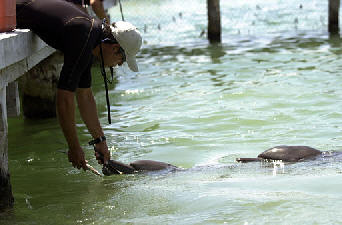|
Sara Rincon, one of the environmentalists allowed into Parque Nizuc, told reporters the three sea corrals holding the mammals were too small. The activists also complained several dolphins appeared to be in shock because they were hardly moving.
Officials for Mexico's federal environmental agency said they met the plane that brought the dolphins Tuesday and all 28 had survived.
Environmental groups, including Greenpeace, have repeatedly insisted more than 30 dolphins were actually loaded onto the plane and that two were seen being pulled dead from the sea shortly after arriving in Cancun.
However, Rincon and others said photos of the allegedly dead dolphins were not clear enough to offer as proof.
Activists and the Australian government had asked Mexico to block the dolphins' arrival. But officials from the Mexican environmental protection agency said Parque Nizuc had met all legal requirements.
At a news conference in Mexico City on Thursday, Greenpeace continued to maintain the dolphins were imported illegally, saying officials failed to get proper authorization from the Solomon Islands.
Irene Blanco, of Mexico's federal comptroller's office, said she was investigating environmentalists' complaints the government violated its own laws and regulations. She said her report was expected in 15 days.
Over the past five years, ethnic conflicts have devastated the Solomon Islands, an impoverished South Pacific state of nearly 500,000, and a multinational intervention force arrived Thursday to try to restore order.
On Thursday, Greenpeace demanded the Mexican government seize the dolphins and send them back to the Solomon Islands, even though activists had earlier derided the long plane trip as a danger to the animals.
Activists argue the dolphins could spread disease to other marine life off the coast of Cancun and should be in their natural habitat.
"It is appalling that Mexican authorities are involved in the looting of nature and the trafficking of species," said Greenpeace's director in Mexico, Alejandro Calbillo.
Parque Nizuc is one of several Cancun attractions that charge tourists $100 or more to swim with dolphins.
The park said it plans to train the new dolphins over the next four months to interact safely with humans.
Most large water parks, including those in the United States, use only dolphins they breed in captivity. But the growing popularity of parks that allow tourists to swim with dolphins has encouraged some parks to seek captured animals.
While some visitors to Parque Nizuc said they didn't mind the new additions, Julie Pritchett of Mobile, Ala., said she refused to go to the park because they held dolphins in captivity.
"All animals should be free," she said.
Top
|
